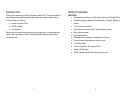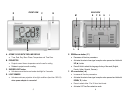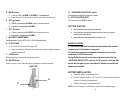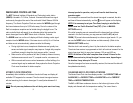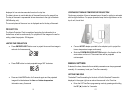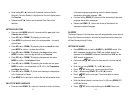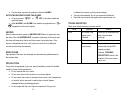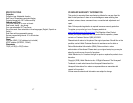
9
WWVB RADIO CONTROLLED TIME
The NIST (National Institute of Standards and Technology) radio station
(WWVB) is located in Ft. Collins, Colorado. It transmits an exact time signal
continuously throughout the most of the continental United States at 60 KHz
frequency. The Atomic Projection Clock can receive this WWVB signal through
the internal antenna from up to 2,000 miles away. Due to the nature of the
Earth’s ionosphere, reception can be limited during the daylight hours. The
radio controlled clock will search for an alternate station that receives the
atomic time signal from the NIST Atomic clock in Boulder, Colorado.
The WWVB tower icon on the unit’s display will flash indicating a radio signal
reception from the WWVB station. If the tower icon is not fully lit, or if the time
and date are not set automatically, please consider the following:
• During night-time hours, atmospheric disturbances are typically less
severe and radio signal reception may improve. A single daily reception
is sufficient enough to keep the clock accuracy within 1 second.
• Make sure the unit is positioned at 8 feet (2 meters) distance from any
interference source such as a TV, computer monitor, microwave, etc.
• Within concrete wall rooms such as basements or office buildings, the
received signal may be weakened. Always place the Atomic Projection
Clock near the window for better reception.
ATOMIC CLOCK OPERATION
Immediately after installation of batteries, the clock will beep and display all
available LCD segments for a moment. Then the atomic time signal receiver
will start searching for the atomic time signal. It usually takes between 5-8
minutes.
NOTE
: Do not press any buttons on the unit during auto search as it may
10
interrupt product’s operation, and you will need to start the set up
procedure again.
If the reception is successful and the atomic time signal is received, the date
and time will be set automatically, and the [
] icon will appear on the display.
NOTE
: It is necessary to set your Time Zone, keeping in mind that the
default zone is a Pacific Standard Time (PST). (Refer to MANUAL
SETTINGS section)
If the initial reception was not successful and the time signal has not been
received in this first 8 minutes, you may press and hold the UP ( ▲) and
DOWN ( ▼) arrow buttons simultaneously to enforce a signal search. Or, you
can use the MODE button to set the time and date manually. (Refer to the
MANUAL SETTINGS section).
After the clock is set manually, place it by the window for the better reception.
The atomic time receiver is programmed so that it will continue to search for the
atomic time signal daily for every hour between 1:00 am and 4:30 am.
NOTE
: At the time of the initial reception allow at least 24 hours for the
atomic time receiver to pick up the signal. In some cases, depending on
the location, it may take up to 72 hours.
Once the time signal has been successfully received, the time and the date will
be updated automatically.
CALENDAR AND CLOCK DISPLAY MODES
The Atomic Alarm Clock has three display modes – the CURRENT TIME and
ALARM ONE, the CURRENT TIME and ALARM TWO and the CURRENT
TIME and INDOOR TEMPERATURE. .
The AL1 or AL2 alarm modes are shown on the bottom right corner of the
display and alternate with the temperature reading. The current time is




